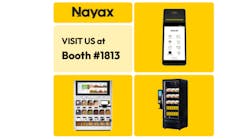In past articles, we have covered many areas of vending technology. We have discussed vending management systems (VMS’s), debated telemetry and cashless operations, reported on prekitting, reviewed pick to light structures and addressed touchscreen options. In this article, we’ll attempt to lay out some of the options operators have for making all these technologies work together seamlessly, even if they are from different suppliers.
It is an exciting time in vending. The existing solutions providers have been adding more functionality to their different systems, newly evolved NAMA vending data interchange (VDI) standards allow these systems to function better together and new and innovate solutions continue to come to the market. It is no longer the case that an operator needs to make an “all or nothing” bet on a single solutions provider – nearly all these systems can be made to work together in several different ways.
Typical technology deployment
The level of technology sophistication seen in vending companies varies from virtually nothing in some operations to progressive companies that are fully deployed with cashless/telemetry, advanced VMS’s, back end pick-to-light systems and are experimenting with other new technologies to enhance the consumer experience. Because of that, we need to make certain assumptions. Here is a typical operator’s journey through technology:
- Installs some type of VMS for accountability
- Moves to item level tracking using a VMS or telemetry provider
- Executes prekitting on some or all routes.
- Adds a pick-to-light or similar system in the warehouse to make prekitting as efficient as possible.
- Launches telemetry and/or cashless on some or all machines
- Implements a dynamic scheduling system
- Installs screens or other consumer facing engagement technology
While there are certain dependencies in this type of rollout (for example, very few operators rollout dynamic scheduling without telemetry on the machines), other technologies, like touch screens and cashless solutions, can be rolled out at any time by any operator, with some optional dependencies that we will get into later.
Additionally, many traditional vending operators are also investing in micro markets and some initial work has been done to integrate micro markets into existing VMS and pick-to-light systems as well.
More capabilities and providers
The vending landscape has changed in the past few years as existing providers have added more capabilities to their systems and new providers have entered the market. While operators have never had so many choices for solutions providers and specific functionality, these options can sometimes seem overwhelming.
One example is that most traditional VMS providers now have modules to do prekitting and dynamic scheduling, but these modules can also come from telemetry providers that integrate data into an existing VMS. Another example is that all cashless providers now provide telemetry data, and virtually all traditional telemetry providers offer cashless solutions. At least one telemetry provider has also moved into the VMS space.
For operators considering a VMS solution, choices now include traditional software licensing models (typically more money up front), and hosted Software as a Solution (SaaS) offerings a pay as you go model. How micro markets fit into the existing systems is noted in Figure 1.
Figure 1 – Vending Solutions Providers, (And Offerings) Products And Features
This list of general capabilities was provided by the technology solutions providers. Specifics vary by provider.
VDI puts it together
Operators may now be asking “But how do these solutions all work together?” Let us introduce VDI or vending data interchange.
Previously, NAMA defined the standard MDB and EVA/DTS (DEX) standards. Although it has taken some time for these standards to be universally applied, virtually all payment system peripherals work inside vending machines (via MDB), and virtually all VMS handhelds and telemetry boxes can read DEX data from a machine.
However, many operators were using different telemetry and VMS systems and wanted a way to get vending machine data from one system to another. Therefore, in 2009, a new task force was assembled by NAMA, which included most of the technology providers, in order to establish standards to solve this type of problem.
“The purpose of the VDI task force is to create standards that make it easier for operators to adopt new technologies by helping to address some of the challenges related to system integration,” said Chris Lilly, VDI Task Force chair and vice president of IT for the Compass Group.
On May 1 2010, the NAMA VDI Standards – VDI S2S DEX 1.0 were officially published, and by this time several “early adopter” operators and solutions providers already had the standards in place to exchange DEX data. Today, many operators of all sizes who have a VMS and telemetry/cashless installed are using this standard on many of the machines. Figure 2 shows a matrix of current providers using VDI standards to support compatibility across the different systems.
Creating the VDI standards is a win-win for the industry and credit should be given to the solutions providers for participating. “NAMA VDI Task Force members sign a participant agreement that enables the free exchange of ideas without consideration of attribution or ownership consequence,” explained Michael L. Kasavana, NAMA Endowed Professor, School of Hospitality Business, Michigan State University. “As a result, comprehensive problem statements, non-proprietary naming conventions, enduring industry standards and effective documentation are being developed in a meaningful way. The participating industry suppliers are to be commended for their commitment to creating and endorsing feasible standards for vending data interchange.”
Figure 2 -- Compatibility Matrix Between Technology Solutions Providers
This list of compatible systems was provided by the technology solutions providers. Specifics vary by provider.
Non-VDI integration
Some technology solutions providers also implemented custom interfaces between their systems and various other solutions providers for the benefits of their customers. In many cases these solutions are in place and provide value to operators today, such as the Cantaloupe Systems SeedSync utility, which allows Cantaloupe Seed users to utilize Seed’s prekitting and dynamic scheduling functionality with many VMS solutions, even ones that don’t directly support these technologies.
Another example is VendScreen’s VSSync utility, which integrates with multiple VMS’s to allow VendScreen’s system to extract planogram data from the VMS. That allows the planograms shown on the VendScreen device to always be in sync with what is currently in the machine.
Future of VDI
The VDI task force continues to meet at least twice a year to solve additional data exchange needs. These have been broken down into three broad categories: server to server, device to server and digital media. The last is a very exciting initiative. The NAMA Digital Media Working Group is hoping to allow operators to generate new revenue streams off of digital media either installed on the machine, or perhaps even on a mobile device that interacts with the machine. Figure 3 contains a listing of the current and future NAMA initiatives on digital standards.
Figure 3 – Current and future NAMA VDI and other digital standards
Server to Server (S2S) data exchange is meant to be implemented by two servers connected to the web over web services.
Device to Server (D2S) data exchange between devices (telemeters / smart devices) generally over the internet, but the assumption is that data usage must be kept to a minimum to minimize cellular costs.
Micro market integration with VMS’s is also being addressed with VDI. Several suppliers and solutions providers are working together on the task force under S2S POS Data. The group hopes to have a standard ready for publication prior to spring 2014.
Future vending technology
While past technology efforts have focused mainly on the supply chain and have vastly increased operator efficiencies for the delivery of product in vending machines (and micro markets), future efforts are likely to focus more on changing and enhancing the consumer experience in vending.
Some of the most exciting will likely include alternative payment options, including digital wallets, cloud based payments and non-credit card sources like PayPal, and Pay by Text options. Increased availability of stored value and loyalty systems including single platform solutions that are integrated across vending and micro markets are also possible.
Increased usage of interactive touchscreens to provide a more personalized consumer experience, including loyalty, promotions, advertisements and special offers will appeal to the users in the future. These will likely be similar to the RedBox interaction, but within traditional vending. There might also be increased interaction between smart vending machines and mobile apps.
Whether new to technology in vending or searching for how to move to the next level, the vending solutions today have never been better. There are more options and more systems that work together than ever before. Perhaps the best part is that through the NAMA VDI task force, the solutions providers are cooperating on further standards, to ensure current and future interoperability.

Glenn Butler
Glenn Butler was a founder of VendScreen and served as CTO. He also runs a M2M and vending focused consultancy called CTO Services. He can be reached and [email protected] or 781-248-3122.








